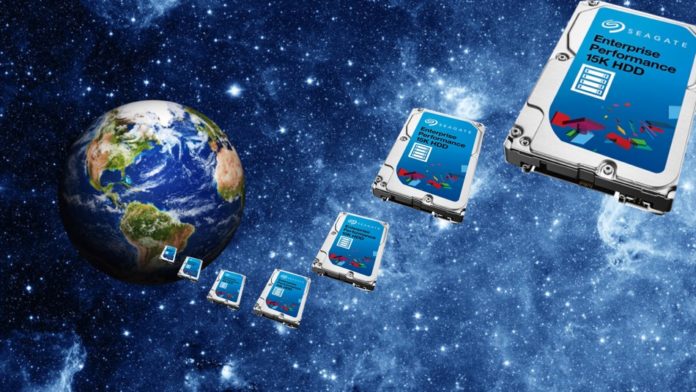The main storage technology themes in 2023 were capacity increases in disk and the possibility of SSDs replacing them. Dual actuator technology underwhelmed.
We started 2023 with Western Digital shipping 22 TB conventional magnetic recording (CMR) disk drives and 26 TB shingled magnetic media recording (SMR) drives with zones of overlapping write racks. These are 3.5-inch nearline drives spinning at 7,200 rpm. Seagate caught up with WD in April, announcing its own 22 TB HDD, the Ironwolf Pro, and Toshiba reached the 22 TB level in September with the MG10F.
All these 22 TB drives have 10 platters and the enclosures are helium-filled.
Seagate seemed on the cusp of releasing its HAMR (heat-assisted magnetic recording) technology with a roadmap to 50 TB capacity and beyond. Back in April 2021, Seagate CEO Dave Mosely said the company was planning to “begin shipping a few versions of 20 TB [HAMR] drives in the second half of the calendar year.” This drive was eclipsed because by September of that year, Seagate shifted focus to discussing gen 2 HAMR drive technology with a 30 TB drive in development, and general delivery in the 2022-2025 period.
It wasn’t delivered in 2022. Seagate CFO Gianluca Romano revealed coming HAMR drive capacity points in a financial analysts briefing session in June this year. The first HAMR drive will be 32 TB, with 36 TB next, 40 TB after that, then 50 TB. Luca told his audience to expect an 18-20 month gap between the capacity points.
We didn’t see a 32 TB HAMR drive this year. Seagate announced a 24 TB CMR drive in October this year. We understand this is to be its last CMR drive. New drives after this will use HAMR tech. Western Digital announced its 24 TB product in November, accompanying it with a 28 TB SMR version.
In one sense it has been a bad couple of years in which to introduce new and high-capacity drive tech. The pandemic and following general economic malaise caused a downturn in disk drive sales as the large buyers started using up their inventory instead of buying new drives. That meant the HDD manufacturers had to reduce their manufacturing capacity, which meant fewer HDD units were passing through their factories, putting up per-drive production costs. This was a disincentive to introducing even higher-capacity drives, which would have probably caused a further drop in disk drive unit shipments.
However, the disk drive market appears to be at the start of a recovery.
After foreshadowing it in June, Seagate announced in November that its Corvault intelligent JBOD was using two kinds of HAMR drives, without revealing their capacity. We estimated they were 21 TB and 28 TB drives, but a Seagate spokesperson said that Corvault used “Exos X drives with HAMR technology ranging up to 29 TB.”
Neither Toshiba nor Western Digital used microwave-assisted magnetic recording (MAMR) in their 2023 drive products. Instead they used an offshoot with aspects of MAMR tech used to increase the signal strength of their CMR drives and enable higher capacities. For example, Toshiba used FC-MAMR (Flux Control MAMR), which involves a microwave flux control phenomenon to improve write signals at high areal densities.
The overall results of the three suppliers’ R&D in 2023 was to expand nearline drive capacity by 2 TB (9-10 percent). If Seagate does introduce a 32 TB HAMR drive in 2024, that will be an 8 TB jump, an increase of 33.33 percent. That will give Western Digital and Toshiba something to aim for.
A significant jump in disk drive capacity is needed because commercial SSDs are now available at 30.72 TB and 61.44 TB capacity points. Pure Storage is using 75 TB flash drive modules in its systems and has said it will reach a 300 TB capacity point in 2026. Seagate’s HAMR promises to give us 50 TB in the 2024/2025 period and 100 TB by 2030. On its own, that’s not enough. Unless HDD technology development can continue giving HDDs a significant cost/TB advantage over SSDs, what Pure is claiming will happen may well be turn out to be the case – for markets where the limited write endurance of SSDs is not an impediment to their use.
Another disk technology that should be significant but seems to be almost downplayed by suppliers is dual-actuator technology, with the potential to double read access speed. Western Digital introduced dual-actuator drives in January 2023 and Seagate introduced its MACH.2 multi-actuator drives in November. This was after Seagate first introduced its twin-actuator MACH.2 tech with 14 TB Exos 2X14 drives in 2021. Dual-actuator drives lose a platter due to the space required by the second actuator inside the drive’s enclosure. This decrease in capacity may be more important to nearline drive buyers than the increase in drive IO speed, and that could be why the dual actuator announcements may not have moved the market as much as hoped.








